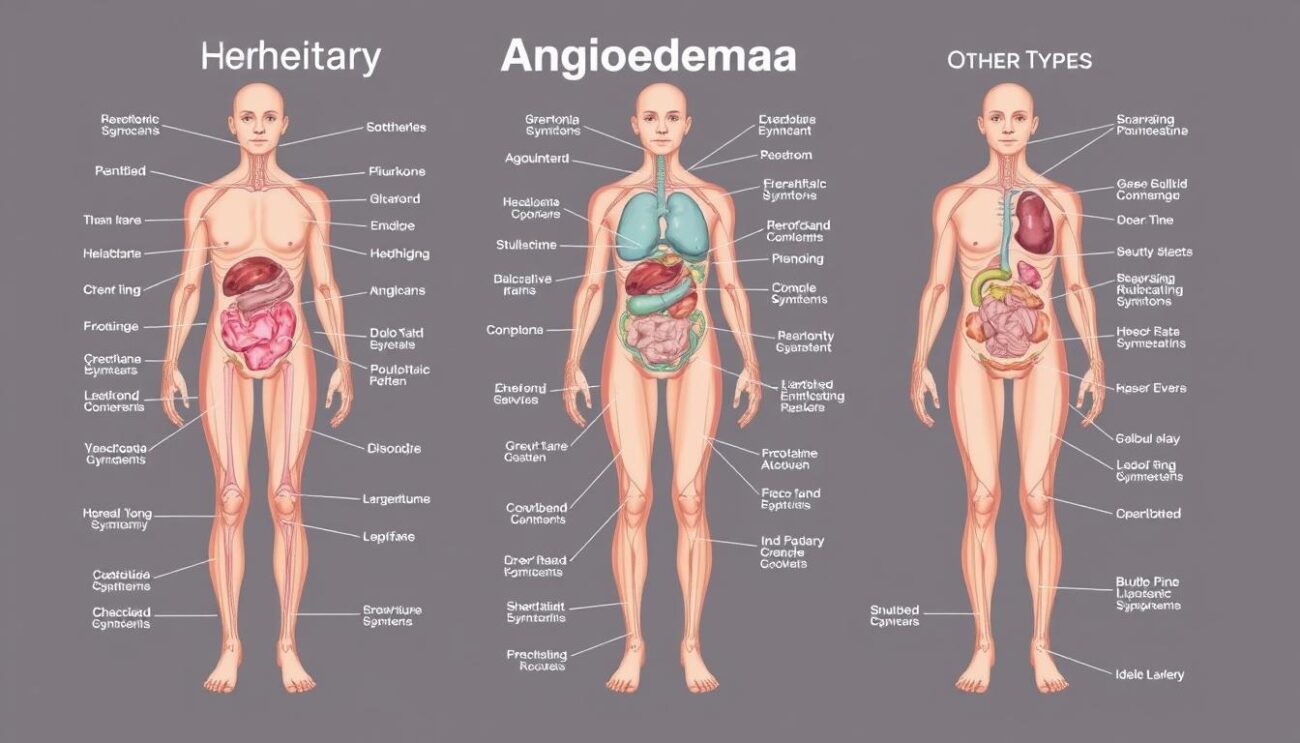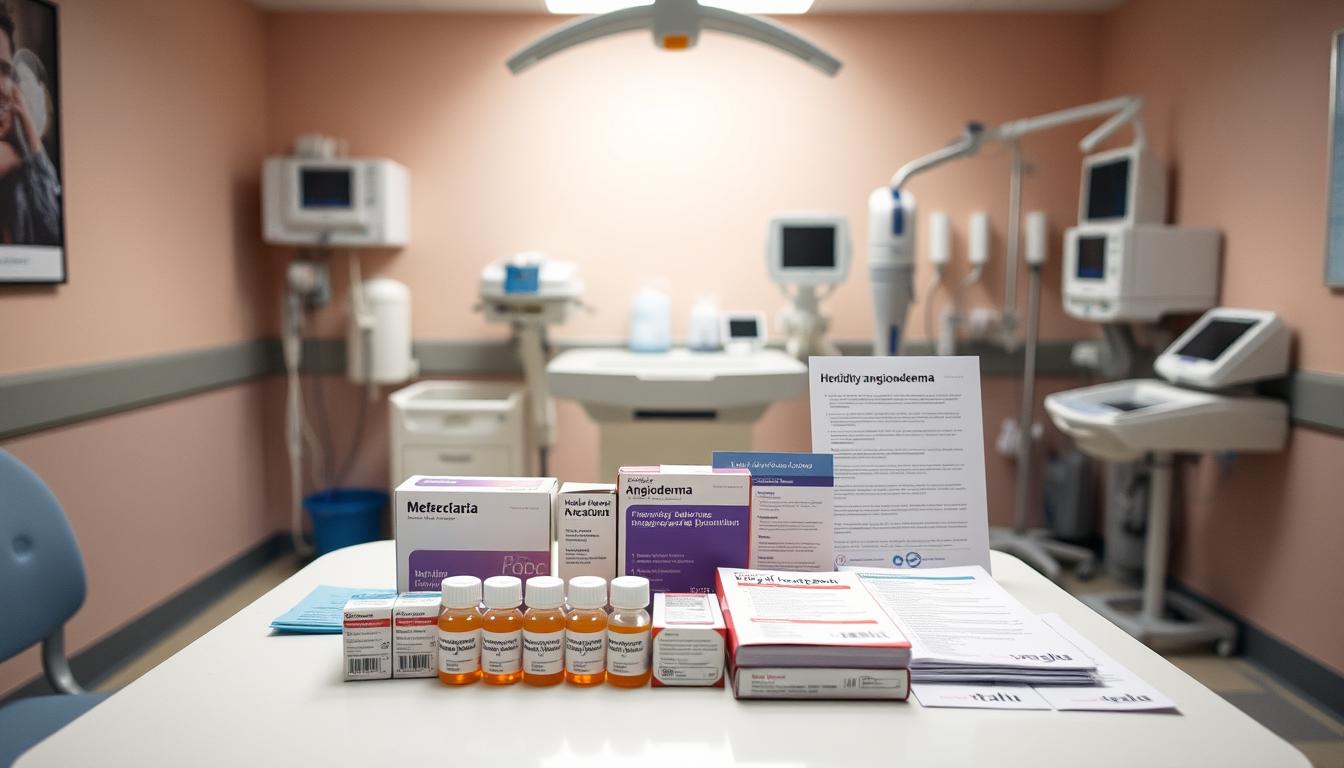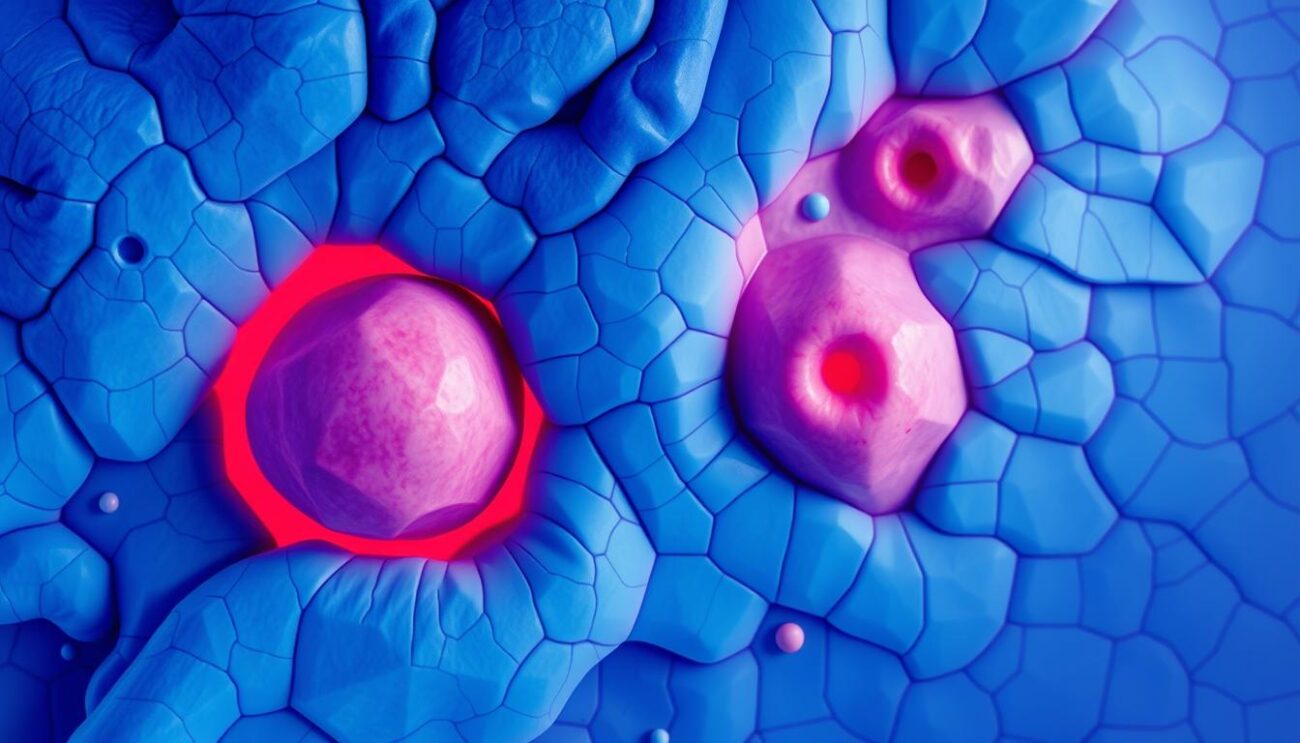Hereditary angioedema (HAE) is a rare genetic disorder. It causes severe swelling in different parts of the body. This includes the airways, skin, and stomach. Finding the right treatment is key to managing this condition and avoiding serious problems.
What are the best ways to treat hereditary angioedema’s severe symptoms? How can patients and doctors work together to improve care and lower the risk of serious issues? This guide will look at the newest treatments for HAE. It aims to help patients and doctors alike.
Key Takeaways
- Hereditary angioedema is a rare, genetic disorder characterized by recurrent episodes of severe swelling.
- Effective treatment options are crucial to managing HAE and preventing life-threatening complications.
- The article will explore a range of acute and prophylactic therapies for HAE, including C1 inhibitor replacement, bradykinin inhibitors, and emerging treatments.
- Optimizing care and reducing the risk of complications requires collaboration between patients and healthcare providers.
- The guide will provide valuable insights into the latest advancements in HAE treatment to empower patients and enhance clinical practice.
Understanding Hereditary Angioedema
Hereditary angioedema (HAE) is a rare genetic disorder. It’s caused by a lack or problem with the C1 inhibitor (C1-INH) protein. This protein helps control the body’s inflammatory response.
There are two main types of HAE: type 1 (HAE-C1-INH) and type 2 (HAE-C1-INH). Both types are linked to mutations in the SERPING1 gene, which codes for C1-INH.
Types and Causes
Type 1 HAE has a low level of C1-INH. Type 2 HAE has a C1-INH protein that doesn’t work right. Both types are caused by problems in the SERPING1 gene.
Epidemiology and Onset
HAE is rare, affecting about 1 in 50,000 individuals. Symptoms usually start in the first 20 years of life. This is different from acquired angioedema, which often starts later.
About 25% of HAE cases come from new mutations. The rest have a family history of the condition.
“Hereditary angioedema is estimated to affect 1 in 50,000 people worldwide, with hereditary angioedema due to C1-INH deficiency accounting for the vast majority of cases.”
Symptoms and Diagnosis
Hereditary angioedema (HAE) causes swelling in the skin, stomach, and upper airway. This swelling is not itchy but can be very painful. It’s especially painful in the abdomen, where it can block the bowel.
The most serious issue is swelling in the upper airway. This can lead to asphyxiation, though it’s rare. Attacks can last 2-5 days and may be triggered by trauma, infections, stress, or certain medications.
Clinical Presentation
The symptoms of hereditary angioedema vary from person to person. Even the same person can experience different symptoms over time. Common symptoms include:
- Swelling of the skin, which can affect the face, lips, limbs, or genitals
- Abdominal pain and swelling, which can mimic a bowel obstruction
- Swelling of the upper airway, which can lead to difficulty breathing and potentially life-threatening asphyxiation
Evaluation and Testing
Diagnosing hereditary angioedema involves both symptoms and lab tests. The first step is often checking C4 levels, which are usually low in HAE. To confirm, doctors look at C1 inhibitor protein levels and function.
In type 1 HAE, both levels and function are low. In type 2 HAE, the protein level is normal or high, but the function is low. Genetic testing for SERPING1 gene mutations can also help confirm the diagnosis, especially when symptoms and lab results are unclear.
| Test | Findings in Hereditary Angioedema |
|---|---|
| C4 levels | Often low |
| C1 inhibitor protein levels | Low in type 1 HAE, normal or elevated in type 2 HAE |
| C1 inhibitor function | Decreased in both type 1 and type 2 HAE |
| Genetic testing | Mutations in the SERPING1 gene |
Getting a correct diagnosis early is key to managing hereditary angioedema effectively.
Treatment for Acute Attacks
People with hereditary angioedema (HAE) face unpredictable and dangerous acute attacks. The main treatment aims to stop the swelling by targeting the cause. This is the overproduction of bradykinin, a key player in swelling.
C1 Inhibitor Replacement Therapy
C1 inhibitor replacement therapy is a key treatment for HAE attacks. It uses either plasma-derived or recombinant C1 inhibitor to replace the missing or faulty C1 inhibitor. Berinert, Cinryze, and Haegarda are approved for this treatment. They can be given through an IV or under the skin.
Kallikrein Inhibitors
Kallikrein inhibitors are another treatment for HAE attacks. They block kallikrein, a part of the bradykinin pathway. Ecallantide (Kalbitor) and icatibant (Firazyr) are approved for this use. Icatibant can be given by the patient at the start of an attack, making it easy to use at home.
“Early administration of treatment during an acute attack is reported to be more effective, prompting many patients to prefer self-administration at home to avoid attending A&E.”
These targeted treatments for HAE attacks have shown to be effective in studies. They give patients better ways to manage their condition. This can also reduce the need for emergency room visits.
Hereditary Angioedema Treatment: Prophylactic Options
Preventive treatments are key for managing hereditary angioedema (HAE). These treatments help reduce how often and how severe HAE attacks are. Some main options include:
- C1 inhibitor replacement therapy (Cinryze, Haegarda): These therapies give the body the missing C1 inhibitor protein. This helps control the body’s inflammatory response.
- Kallikrein inhibitor lanadelumab (Takhzyro): This injectable blocks kallikrein, an enzyme that starts the inflammatory process leading to HAE attacks.
- Oral kallikrein inhibitor berotralstat (Orladeyo): This daily pill also stops kallikrein to prevent HAE attacks.
Choosing the right preventive therapy depends on the patient’s needs and how well they respond to treatment. [Cinryze is not considered medically necessary for HAE treatment because it doesn’t show better safety and effectiveness than other C1 esterase inhibitors like Berinert and Haegarda]. Berinert, Ruconest, and Kalbitor are proven to treat acute HAE attacks and are considered medically necessary.
| Prophylactic Therapy | Mechanism of Action | Administration |
|---|---|---|
| C1 inhibitor replacement (Cinryze, Haegarda) | Replaces deficient C1 inhibitor protein | Intravenous or subcutaneous injection |
| Lanadelumab (Takhzyro) | Kallikrein inhibitor | Subcutaneous injection |
| Berotralstat (Orladeyo) | Oral kallikrein inhibitor | Oral capsule |
Firazyr, Haegarda, and Takhzyro are self-administered injections for HAE obtained under the members’ pharmacy benefit. [Ruconest is given intravenously and is a recombinant C1 esterase inhibitor. Kalbitor is a subcutaneous injection for HAE symptoms and acts as a plasma kallikrein inhibitor.]
Role of Androgens and Antifibrinolytics
Androgens like danazol and antifibrinolytics like tranexamic acid and aminocaproic acid were once used to prevent hereditary angioedema (HAE) attacks. They try to stop or lessen the severity of HAE by affecting its causes.
Efficacy and Limitations
Androgens boost C1 inhibitor levels, which is low in HAE patients. This helps manage symptoms and attack frequency. But, their side effects and the existence of better treatments have made them less popular.
Androgens can lead to high cholesterol, obesity, and other issues in females. A study in China showed managing HAE is tough, with androgen use being a big concern.
Antifibrinolytics mainly target the fibrinolytic system, not the kallikrein-kinin pathway. They might have fewer side effects but are less effective in preventing attacks.
A survey in China showed the need for better HAE care. It highlighted the need for treatments that are both effective and easy to tolerate.
“The use of attenuated androgens and antifibrinolytics in HAE management has become less common due to their adverse effects and the availability of more targeted therapies.”
Emerging Therapies and Clinical Trials
The treatment for hereditary angioedema (HAE) is changing fast. New and promising treatments are being developed or tested in clinical trials. These include novel bradykinin pathway modulators like monoclonal antibodies and small molecules. They target different parts of the cascade.
Recent studies have shown the potential of these new treatments. For example, a study is looking at Cinryze for long-term prevention in kids aged 6-11 for 12 weeks (NCT 02052141). Another study is checking if Ruconest works for acute attacks in kids aged 2-13 (NCT01359969).
There’s also a trial on icatibant for acute attacks in kids over 2 and teens under 18 (NCT01386658). These studies aim to improve treatment options, especially for kids.
“The continued research and advancement of these emerging therapies hold the potential to further improve the management and outcomes for individuals with hereditary angioedema.”
As we learn more about HAE, new treatments are being developed. These treatments could change how we manage HAE, offering hope for better lives for patients.
Management Strategies and Care Plans
Managing hereditary angioedema (HAE) is more than just medicine. It’s about avoiding things that can trigger attacks. This includes avoiding trauma, infections, stress, and certain medicines like ACE inhibitors and estrogens. A good care plan is key. It should include long-term treatments, quick action for attacks, and a plan for before surgeries.
Trigger Avoidance
Staying away from triggers is vital for hereditary angioedema management. Patients need to learn what can cause attacks. This includes:
- Avoiding physical trauma, such as dental procedures or surgery
- Maintaining good hygiene and promptly treating infections
- Practicing stress management techniques to manage anxiety and emotional triggers
- Carefully monitoring medication use, particularly ACE inhibitors and estrogens
Self-Administration and Education
Many treatments for hereditary angioedema are meant for patients to use themselves. Teaching patients how to handle their attacks can greatly improve their life. It’s important to educate them on how to use their medicines and spot early signs of an attack.
“Self-management was highlighted as a comprehensive approach to managing chronic conditions in a study by Grady PA and Gough L in 2014.”
By teaching patients to avoid triggers and how to manage their condition, doctors can help them take charge. This approach can greatly improve their health and well-being.
Differentiating from Other Angioedemas
It’s important to know the difference between hereditary angioedema (HAE) and other types of angioedema. Histamine-mediated angioedema is linked to urticaria and itching. It usually gets better with antihistamines, epinephrine, and steroids. But, HAE is different because it’s caused by too much bradykinin.
Knowing the signs of hereditary angioedema is key to treating it right. It can be hard to diagnose because its symptoms are not always clear. But, new genetic tests are helping doctors find the cause in some cases.
- Only 10 out of 32 patients with hereditary angioedema (HAE) had pathogenic variants identified through conventional testing, emphasizing the need for more comprehensive genetic testing methods.
- In cases of HAE with normal C1-inhibitor levels (nC1-INH HAE), the pathogenic variant was identified in only 1 out of 21 patients in the study, showing a low diagnostic yield.
- Approximately 5-15% of HAE cases remain molecularly unsolved despite known monogenic etiology affecting a single gene.
It’s vital to tell hereditary angioedema apart from histamine-mediated angioedema for the right treatment. By knowing the differences, doctors can give patients the best care for their condition.

Conclusion
Hereditary angioedema is a rare and serious condition. It needs a detailed, multi-step approach to manage it. The availability of targeted therapies has greatly improved care for those with it. Understanding the condition’s causes and symptoms helps doctors manage it better.
Research has given us a lot of information about hereditary angioedema. It has shown us the symptoms, affected organs, and how it progresses. It also revealed the genetic and pathogenic mechanisms behind it.
This research has led to better treatments for hereditary angioedema. These new treatments are more effective and safer than old ones. This shows how far we’ve come in treating this condition.
The progress in treating hereditary angioedema is clear. From just relieving symptoms to using targeted therapies, we’ve made a big leap. As we learn more, doctors can give better, more personalized care. This improves patients’ lives and reduces the impact of this rare disorder.




